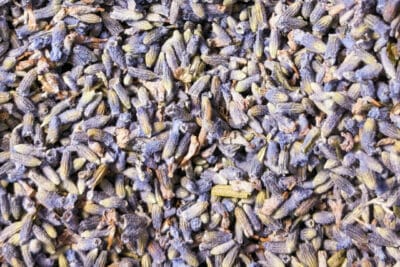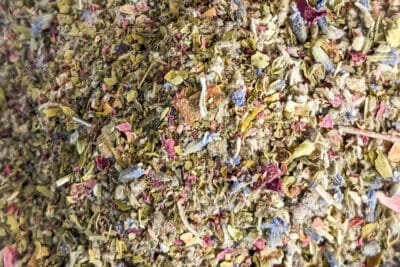Lavender – Aromatic and Relaxing Herb
Lavendula
Also referred as:
Lavender flower
🍃 Texture when dried
Small and soft purple flower
👅 Taste
Sweet and floral taste
❔ Usage
Used in herbal blends, herbal tea and as a fragrance
💨 Smoke
Moderate smoke
🗜 Harshness
Medium
⚡ Effects
Mildly relaxing but can potentiate cannabis
Table of Contents
Introduction
Lavender is a beautiful, fragrant herb known for its purple blossoms and calming aroma. It’s been cherished for centuries for its soothing properties and is often used in teas and culinary dishes. When seeking relaxation, many people enjoy sipping lavender tea or incorporating the dried flowers in personal care products.
Smokably products with Lavender :
-
 LavenderCAD $8.00 – CAD $12.00
LavenderCAD $8.00 – CAD $12.00 -
 Skull Island▸ Herbal Blend from Skullcap, Mullein, Damiana, Lavender, RoseCAD $12.00 – CAD $18.00
Skull Island▸ Herbal Blend from Skullcap, Mullein, Damiana, Lavender, RoseCAD $12.00 – CAD $18.00
Frequently asked questions
Is it common to smoke Lavender?
While not as common as using lavender in teas or personal care products, some people do choose to smoke dried lavender flowers. It is often combined with other smoking herbs to create a unique and aromatic blend. However, smoking any substance may have potential health risks, so it’s essential to consider this before choosing to smoke lavender or any other herb.
Is Lavender smoked on its own or mixed with other herbs?
Lavender is typically smoked as part of a blend with other herbs rather than on its own. Combining lavender with various herbs can create a pleasant and aromatic smoking experience. Popular herbs to mix with lavender include chamomile, mugwort, and damiana. These blends offer unique flavors and complement the soothing scent of lavender, providing a more enjoyable experience for those who choose to smoke it.
Can Lavender help you quit smoking?
While lavender itself does not directly help quit smoking, some people may find its calming properties helpful in managing stress and anxiety during the process of quitting. However, there is no scientific evidence to support lavender as a treatment for nicotine addiction or as a method to quit smoking. It’s essential to consult with a healthcare professional before using lavender or any other herb as a tool to quit smoking.
Why do people enjoy Lavender ?
People enjoy Lavender for a variety of reasons.
- Calming aroma: Lavender is famous for its distinct and soothing scent, which can help promote relaxation.
- Visual appeal: The beautiful purple blossoms of lavender add a touch of color and elegance to gardens and arrangements.
- Culinary uses: Lavender is occasionally used to add a unique flavor to baked goods, beverages, and other dishes.
- Sleep aid: Some people believe that the calming properties of lavender may help promote better sleep, often using it in pillow sachets or diffusers.
- Personal care products: Lavender is popular in soaps, bath products, and essential oils, thanks to its pleasing fragrance and relaxation benefits.
- Herbal smoking blends: As mentioned earlier, lavender can be combined with other herbs in smoking blends to create a pleasant, aromatic experience.
NB. Anecdotal or historical claims should not be construed as health claims. Always consult a health specialist prior to oral consumption of any herb. Consumption of any herbs might have side effects.
How do you make a tea out of Lavender ?
To make a herbal tea out of Lavender, you can follow these simple steps:
- Gather your ingredients: You’ll need dried lavender flowers (around 1-2 teaspoons) and boiling water (1 cup or 8 oz). Optionally, you may add honey or a sweetener of your choice to taste.
- Place the dried lavender flowers in a tea infuser, tea ball, or a teapot with a built-in strainer. If you don’t have these, you can also place the flowers directly in a cup and strain the tea later.
- Pour boiling water over the lavender flowers, then cover and let steep for 5-10 minutes. The steeping time will vary based on personal taste preferences – a longer steep will yield a more robust flavor.
- If using a teacup without an infuser, strain the tea through a fine mesh strainer to remove the lavender flowers.
- Add honey or your preferred sweetener, if desired, and stir. Enjoy the tea while it’s warm for the best flavor and experience.
Lavender tea offers a unique floral taste with a subtle hint of sweetness and a slightly earthy undertone. It is quite popular among herbal tea drinkers, especially those who appreciate its calming properties and aromatic quality. The relaxing scent and gentle flavor make lavender tea an enjoyable choice for many individuals seeking a peaceful moment to unwind.
What does Lavender look like?
Lavender is an attractive perennial herb known for its distinctive appearance. It has the following features:
1. Colorful flowers: Lavender is most famous for its beautiful and small purple, violet, or bluish flowers that grow in elongated, dense clusters called spikes or inflorescences. In some rarer varieties, the flowers can be pink or white.
2. Foliage: Lavender plants have narrow, grayish-green leaves that are smooth and slightly needle-like. They grow opposite each other, directly attached to the stems, and are often covered in fine, silvery hairs.
3. Stems: The plant has woody, branching stems that can appear silver, gray, or brown. These stems can grow up to 3 feet tall (around 90 cm) or even higher, depending on the lavender variety.
4. Growth pattern: Lavenders grow in a compact and bushy form, with a rounded, mound-like shape.
Overall, lavender plants create a striking visual impact in gardens and landscapes, thanks to their vibrant color, rich textures, and delightful fragrance.
How has Lavender been used historically?
Lavender has a rich history of use across various cultures, dating back thousands of years. Here are some notable ways it has been utilized over time:
1. Ancient Egyptians: Lavender was used in the mummification process, and its scent was found in the tomb of Pharaoh Tutankhamun. Egyptians also incorporated lavender in cosmetics and perfumes.
2. Romans and Greeks: Both cultures appreciated lavender for its aroma, using it in baths, as a perfume, and to scent the air in homes. The name “lavender” comes from the Latin word “lavare,” which means “to wash,” indicating its use as a cleansing agent.
3. Medieval Europe: Lavender was valued for its scent and was thought to hold protective qualities. It was often used in potpourris, stuffed into sachets, and strewed on floors to ward off insects and provide a pleasant fragrance.
4. Renaissance: During the plague, lavender was believed to have some protective qualities. People wore lavender around their waists or in small satchels to protect themselves from infection.
5. Victorian Era: Lavender was highly popular among the Victorians. It was used in everything from perfumes, soaps, and cosmetics to home décor and as a flavoring agent.
6. Traditional medicine: Throughout history, lavender has been used in herbal remedies to help with issues such as headaches, anxiety, insomnia, and digestive problems. It’s essential to note that these uses are based on historical practice and may not be supported by scientific evidence.
Today, lavender continues to be appreciated for its soothing fragrance, aesthetic appeal, and potential relaxation benefits in teas, personal care products, and various culinary applications.



